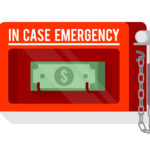In today’s unpredictable economic climate, preparing for unforeseen financial setbacks by establishing a safeguarding reserve is essential.
This post delves into the rationale behind creating such a fund and provides step-by-step guidance on how to effectively build one.
Understanding the Necessity of an Emergency Reserve
Emergency funds serve as a financial safety net designed to cover unexpected expenses such as medical emergencies, home repairs, or sudden job loss. Without this safety buffer, individuals might have to rely on high-interest loans or credit cards, leading to potential debt spirals.
By setting aside a portion of your income, you ensure peace of mind and financial stability. Think of it as insurance against life’s unpredictable challenges.
To further appreciate its significance, consider reading about The importance of having an emergency fund.
Financial experts commonly recommend saving enough to cover three to six months’ worth of living expenses. This benchmark provides a solid foundation, but the exact amount should be tailored to your personal circumstances and risk tolerance.
Where to Begin with Establishing Your Financial Buffer
The first step in securing your financial future is to determine your monthly living costs. Include necessities such as rent, utilities, groceries, and transportation.
After calculating your essential expenses, set a clear target for your emergency savings. A good starting point is to aim for one month’s worth of living expenses, gradually increasing over time.
For actionable steps on getting started, explore Steps to start building your emergency fund.
Strategies for Growing Your Safety Net
Consistency is key when it comes to building your fund. Consider automating your savings to ensure a portion of your income is directly transferred into your emergency account each pay period.
High-yield savings accounts are ideal for your reserve since they offer higher interest rates than standard accounts, allowing your savings to grow over time.
Cutting back on non-essential expenses and allocating any additional income, such as tax refunds or bonuses, towards your emergency fund can accelerate its growth.
Further, diversifying your income streams can provide additional financial security and contributions to your fund. Whether through freelancing, a part-time job, or investing, supplemental income can bolster your savings.
For more tips on enhancing your fund, check out Tips for growing and maintaining an emergency fund.
Maintaining Your Reserve for True Emergencies
Discipline is crucial in ensuring your emergency fund serves its intended purpose. It’s important to define what constitutes an “emergency” and resist the temptation to dip into your savings for non-urgent expenses.
Regularly review and adjust your fund. Life changes such as a new job, moving to a more expensive city, or changes in household size may necessitate adjustments to your savings goal.
Replenish your fund if you ever need to use it. After covering an emergency expense, prioritize restoring your fund to its target level.
Overcoming Challenges in Fund Building
Starting and maintaining an emergency fund can be challenging, especially for those with limited income. Focus on starting small and gradually increase your contributions as your financial situation improves.
Remember, the purpose of this fund is to provide financial security. Every contribution, no matter how small, brings you one step closer to that goal.
In conclusion, building an emergency fund is a fundamental aspect of financial wellness. It provides a buffer against life’s uncertainties, offering peace of mind and stability. Starting may seem daunting, but with the right approach and discipline, anyone can establish and grow their emergency reserve. By recognizing its importance, taking actionable steps to start, and employing strategies for growth and maintenance, you’ll ensure that you’re well-prepared for whatever life throws your way.


